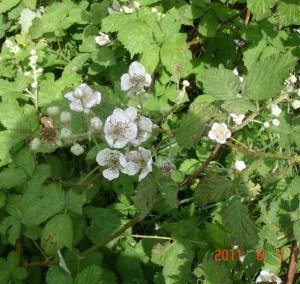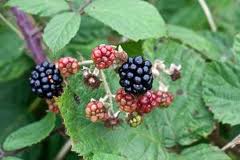Bramble
Latin: Rubus fruticosus agg.
Irish: Sméara dubha
Rubus fruticosus agg., or Bramble, is the name given to an aggregation of native species differing in details of stem angles, thorn, hair or leaf shape and demanding considerable expertise for accurate differentiation and identification. This complexity is due to the bizarre reproductive behaviour of Bramble. These plants, even though they do produce pollen, can produce seeds without pollination taking place so that individual plants can give rise to distinctive populations or species.
Rubus fruticosus, sometimes referred to as “Briars” or “Blackberries”, occurs abundantly around the course in hedgerows and waste areas. It is a perennial with scrambling, woody, thorny stems that, in the past, were used for wickerwork and for securing thatching. The leaves are compound with 3-5 leaflets. The flowers are white or pinkish mauve and first appear in June and the black fruit (Blackberry) is composed of numerous small drupes that adhere to a central receptacle.
The blackberry has been considered a valuable food source since ancient times. They were traditionally eaten mashed up with oatmeal in a kind of porridge but in more recent times they have been mainly used for making jams and tarts. There was a widely held folk belief that blackberries should not be eaten after Halloween, or Samhain, because a pooka (púca) spat or urinated on the blackberries at that time, making them inedible.
Bramble also had a role in traditional medicine. Blackberry jelly was used to cure dropsy and blackberry cordial was valued for its great restorative properties. The leaves of bramble were used to cure diarrhoea in humans and cattle and for a variety of ailments like cuts, bruises and swellings.

